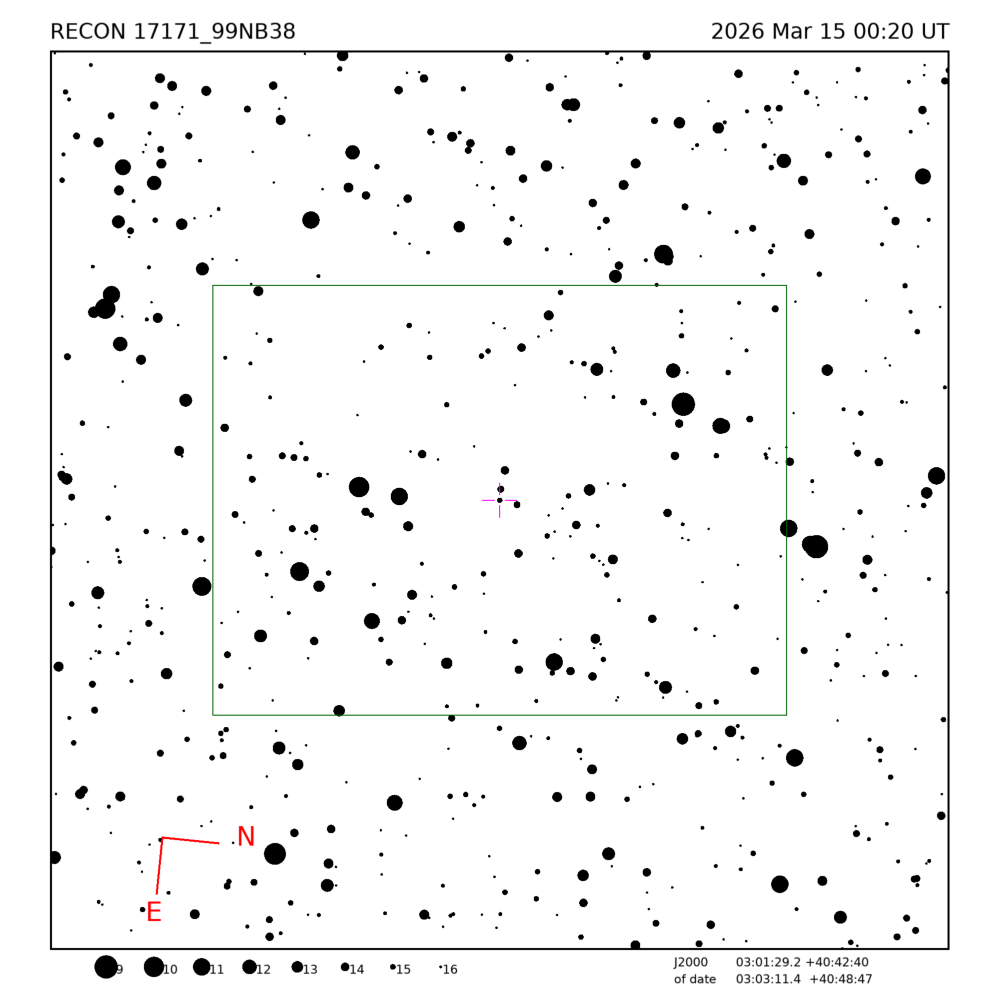
Occultation event with (17171) 99NB38, event index number 3429
Regions able to see the event: US,UVa
Geocentric closest approach at 2026/03/15 00:20:10 UTC
J2000 position of star is 03:01:29.2 +40:42:40
Equinox of date position of star is 03:03:11.4 +40:48:47
Star is 110 degrees from the moon. Moon is 18% illuminated.
Stellar brightness G=16.2, apparent brightess of occulting body is G=16.4
Use an exposure time of 0.70 seconds with the standard RECON-QHY system.
SNR of 3.1 per integration for unocculted signal
Expected flux drop is 54% with SNR of 1.7 for the occulted depth (per occulted point)
Apparent velocity is 29.1 km/sec on the sky relative to the star, or, 25.8 arcsec/hr.
Position angle of asteroid motion is 94.2 degrees
The recommended exposure time corresponds to 20.4 km per image.
The 1-sigma error in the time of the event is 0.2 seconds.
The 1-sigma cross-track error in the shadow position is 28.0 km.
The sky-plane scale is 4068.6 km/arcsec.
Diameter estimates:
46.1 km assuming a 5% albedo, maximum of 1.6 sec for a central chord
18.8 km assuming a 30% albedo, maximum of 0.6 sec for a central chord
Cross-track diameter of 40.9 km used for deployment plan.
Star training set for 17171_99NB38, (2026/03/15 00:20UT) Object RA Dec mag sep mel Aldebaran 04:37:25.6 +16:33:35 0.8 31.65 124 Algol 03:09:53.1 +41:03:17 2.1 1.29 111 22Pi Per 03:00:26.8 +39:45:57 4.7 1.17 109 PPM 045764 03:02:53.5 +40:53:55 8.0 0.10 110 17171_99NB38 03:03:11.4 +40:48:47 16.4 110 Positions are for equinox of date

Star training set for 17171_99NB38, (2026/03/15 00:20UT) Object RA Dec mag sep mel Aldebaran 04:35:55.4 +16:30:29 0.8 31.65 124 Algol 03:08:10.1 +40:57:20 2.1 1.29 111 22Pi Per 02:58:45.7 +39:39:45 4.7 1.17 109 PPM 045764 03:01:11.3 +40:47:47 8.0 0.10 110 17171_99NB38 03:01:29.2 +40:42:40 16.4 110 Positions are for J2000